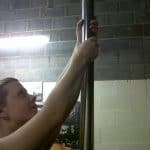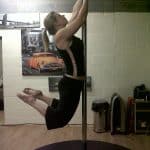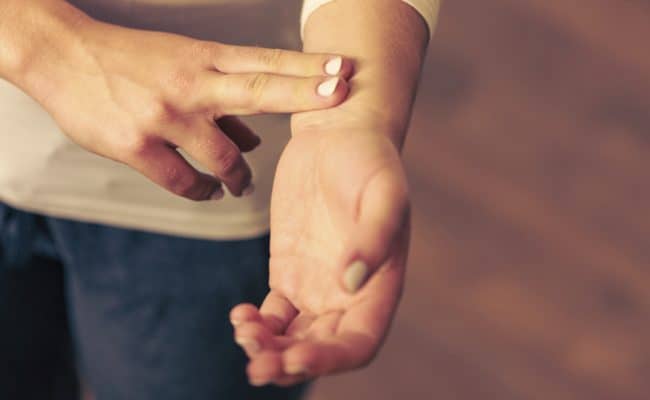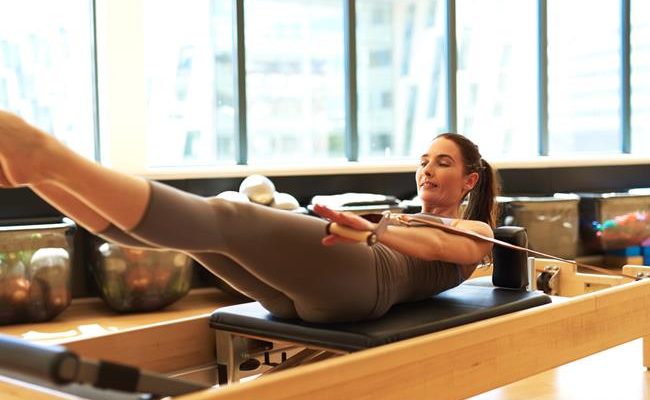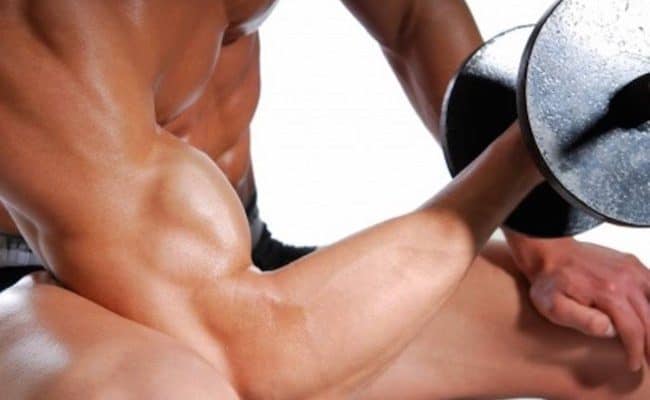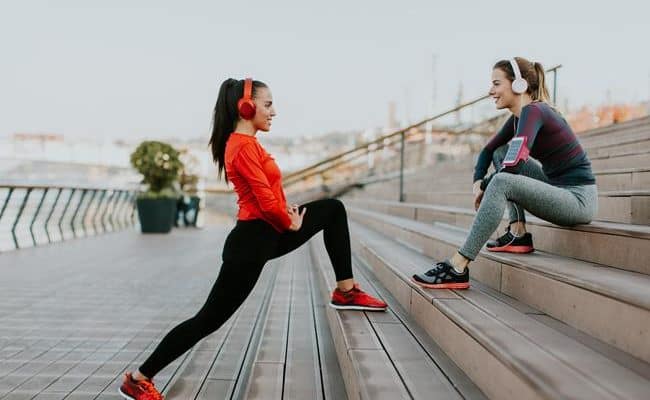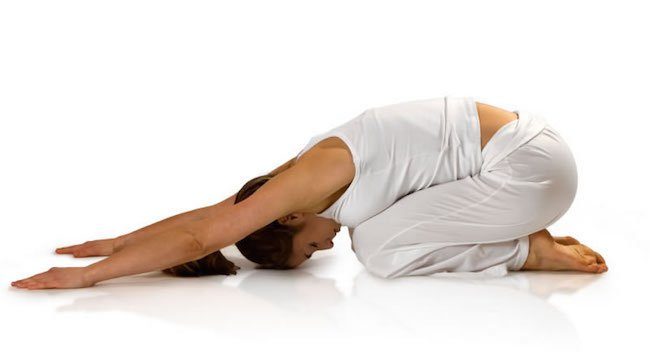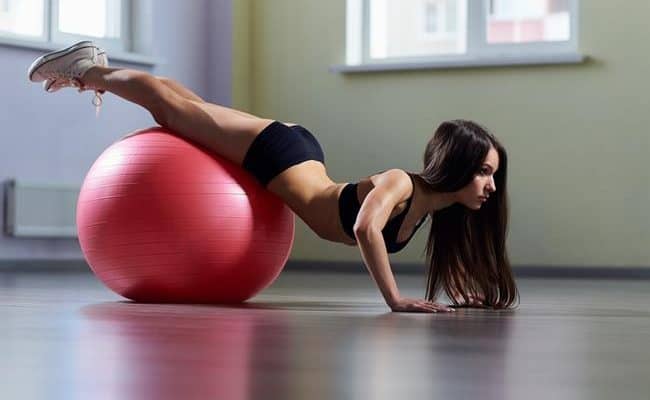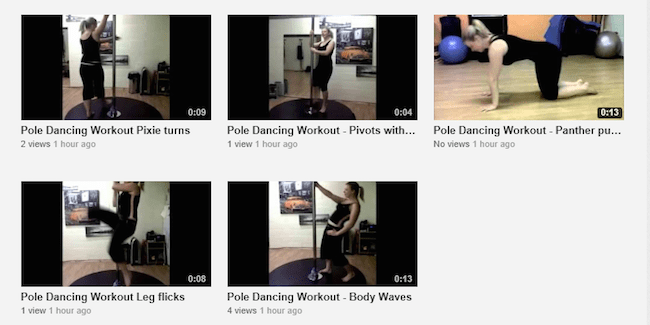
A complete workout (with videos) on how to get fit with pole dancing.
Pole dancing has gained a lot of popularity as a fitness regime in the last few years. It has taken a turn from the ‘sex’ scene and is now considered as a performing art and sport. In a previous article we looked at whether Pole dancing can be used as a fitness regime and gave the thumbs up for a full body workout.
Now we have gathered together a workout fit for the pole. Whether you are already a pole fitness participant or a novice to the sport it can help you improve your fitness and strength. As we have seen in our previous article in order to perform spins and acrobatic tricks on the pole you will need to have a considerable amount of upper body and core strength, agility, balance and flexibility.
Fun and enjoyable way to get fit
This workout will help you build and/or improve those elements and if you are a novice it will help you set the basics for turns and spins. Most of all it will offer you a fun and enjoyable way to get fit. Pole dancing is performed by both men and women (may be surprised on that) so if you are a man why not give it a go!
For some of the exercises you will need to use a pole but for a number of them you can either improvise or they are performed on the floor.
The videos and the photos were prepared exclusively for CalorieSecrets from Samantha Lister pole dance teacher in NBSR studio, Lincoln UK
Workout routine for the pole
Important: Before starting with the main body workout make sure that you do a warm up session for 5-10 minutes. Click here to go to the warm up session first and then come back for the main body workout
Main body Workout
Pole pull ups
This is your classic pull up exercise but with the use of a pole. If you do not have a pole in hand you can perform pull ups in a pull up bar. Keeping the hand grip quite close together if you are using a pull up bar will mimic the pole motion more. However, you will find that it is quite harder to perform than keeping the hands shoulder width apart. You can start by using a wider grip and progress in bringing it together.
Muscles worked: Pull ups whether be it on a pole or a bar are a great exercise for upper body strength. You will be working your biceps and triceps on your arms, shoulder and chest muscles, back and abdominal muscles and your obliques (muscles at the side of your torso).
Note: Keep the exercise slow and controlled and avoid jumping up or using momentum to perform. It is better to go as far as you can even if it is just a couple of inches off the floor and build on it in time, than jumping up to get to the top.
Perform:
- Stand in front of the pole and extend your arms upwards as high as you can. Use a baseball grip (hold the pole as if you are holding a baseball bat – see image below) to hold from the pole.
- Pull yourself upwards and hold for a few seconds.
- Release slowly back to starting position.
- Repeat x5 or as many as you can manage.
Progress to: Pole perch, Pole pull ups from the floor, and Pole climb.
Pull ups from the floor are similar to the standing up ones only a lot harder. You perform the exercise by sitting on the floor with the pole between your legs and keeping the legs straight. The aim is to keep the legs straight and pull your whole body upwards. It does require good abdominal muscles not just arm strength.
Pole perch is basically adding to the standing pull up by bringing your legs forward (pole between the legs) in a chair sitting position and back straight before you lower to the ground.
Pole hangs
Pole hangs are similar with the pole pull ups, only you do not pull yourself upwards. Will help to familiarise your body with sustaining the turns in which you hold on the pole and have your legs in the air unsupported.
Muscles worked: Arm strength and abdominal conditioning.
Perform:
- Standing in front of the pole stretch your arms as high as you can reach and hold the pole on a baseball grip.
- Lift your legs backwards by bending the knees.
- Hold for as the count of 5 or for as long as you can if a novice.
Pole pivots with squats
Learning to pivot on the pole is the first step of learning to spin.
Muscles worked: Mainly leg muscles especially with the added squats. You will be doing some on the arms holding to the pole. This exercise is also good for balance and coordination.
Perform:
- Stand in front of the pole and hold the pole in a baseball grip. Place your feet close to the base of the pole but keep your arms slightly extended so you don’t hit yourself on the pole while pivoting.
- Keep the arms at shoulder level.
- Perform this exercise slowly and in 3 steps at first until you get used to it and then try to make it as one flowing movement.
- Start anticlockwise.
Step 1: Bring your left leg all around the pole placing back to the floor. If you are a very beginner go as far as you can reach with your leg and don’t stretch to reach all the way. Let your body follow you rather than staying rigid.
Step 2: Lower your body into a squat position.
Step 3: Bring the right leg around. It is a full body motion so your body will be following you around and extend the legs back to a standing position as you come around.
- Repeat clockwise and alternate. Best avoid going around the pole in one direction constantly as you can feel dizzy.
- Once you got the hang of the exercise try in performing in one flowing motion.
Progress to: Pole pixie lifts with pirouette and squat. Pole pixies are basically a pivot but in the air. You will need to have developed arm strength slightly before managing. Pirouettes performed at the end with an added squat will work your balance and coordination along with working your hamstrings.
Body waves
Body wave is a relatively easy move to master and if incorporated in a routine it can be a fill up between spins and tricks.
Muscles worked: It mainly works the back and abdominal muscles. Some work is done in the gluts and legs. These areas are worked to a larger extend if you take the body waves to the floor and back up. It is a good move for increasing flexibility on the back.
Progress to: Body waves to the floor and back up
Perform:
- Standing in front of the pole, hold the pole with one hand. You can use both hands for more stability.
- Bring one leg slightly forward and keep the knees soft.
- Start the wave by bringing the chest forward towards the pole.
- Start bringing your chest outwards and bend the knees while bring the abdomen inwards.
- The body should form a continuous wave against the pole.
Note: You can also perform body waves against the wall or against a door.
Leg flicks
Leg flicks can help in getting the bases for inverts and spins such as the cork screw.
Muscles worked: Leg flicks work majority of the body. You will be working your abdominal and leg muscles through the movement. Also arm and back muscles will be worked eccentrically.
Floor work
Panther push ups
This is an easier version of the push ups. It is also the basis for performing a panther move which can you can add to a routine to help you come up from the floor or connect moves.
Muscles worked: Arms and shoulders, back and abdominal.
Perform:
- On the floor, go in a on four’s position.
- Keep the back straight and the arms directly straight under the shoulders.
- Bend the elbows and lower your chest towards the floor by pushing/keeping the buttocks upwards.
- Just before you touch the floor continue by extending the arms and the chest upwards but push your pelvis forward.
- Come back to the starting position.
- Put all together the movement should be as if you are brushing your chest along the floor and then coming back to the start.
- Repeat by 8.
Burlesque leg shows
Different kinds of leg shows are used in burlesque but they can also be used in dance routines if you want to connect moves that go to the floor. It seems like an easy exercise but when performed repeatedly it is surprising difficult.
Muscles worked: Leg muscles are worked but mainly abdominals. Also back and shoulders as stabilisers.
Perform:
- Lying on your back.
- Prompt your upper body on to your elbows.
- Extend the legs and lift them above the floor at approximately 600 angle (if this height is too difficult then lower closer to the floor).
- Bend your right knee and swipe your foot on to the left leg reaching to the knee.
- Lower back to starting position in a similar fashion.
- Repeat with alternative leg.
Ensure that you don’t tilt your pelvis forward. If you find it hard to keep your back into position then try lowering your legs closer to the floor as it would mean that it is too hard for your level of fitness.
Warm up (5-10 minutes)
Always make sure you warm up really well before a workout. Pole dancing uses most parts of the body, so you want to mobilising the joints and moving those muscles. Below are some ‘warm up’ suggestions. Aim for a warm up session to last for about 5-10min.
1. Wrist circles: In pole dancing there are a number of hand grips you can use to perform spins and acrobatic tricks. The wrists tend to take a considerable amount of weight so they will require a good warm up and also developing strength to sustain the strain.
Muscles/area worked: Mobilise wrist joint and works the forearm muscles.
Perform: You can perform wrist circles standing up or sitting down.
- Move your arms slightly away from your body on the side or in front of you. The purpose of extending the arms is so that you allow space for the movement and you don’t hit yourself. You could keep the elbows slightly bend if more comfortable.
- Keep the fingers open but relaxed. Alternatively you can bend your fingers in a fist but do keep them relaxed.
- Circle the wrists outwards as if you drawing circles in the air (Count of ten). Keep the movement controlled on the wrists and not in the whole arm.
- Circle then inwards for the count of ten.
2. Arm circles: As with the wrists your arms will be taking your body weight through them. Upper body strength is the first element you will need to build up in order to perform spins and hold yourself on the pole. Upper arms and shoulders will need to be well warmed up.
Muscles/areas worked: Mobilise the shoulder griddle joint. It works the muscles of both the upper arms and shoulder.
Perform: This exercise can be performed in standing or sitting down.
- Extend your arms to the side forming a cross with your body. Keep arms straight but elbow joints relaxed.
- Move your arms forward in small circles as if you are drawing ‘Os’ in the air (count of 5).
- Slowly enlarge the circles for the count of 5.
- Finish off by coming back to small circles for the count of 5.
- Lower your arms for a few second and repeat with circling arms in the opposite direction (backwards).
3. Ankle circles: Ankles are often overlooked when it comes to warm ups. With walking around the pole, and using the feet to hook on the pole or stabilise yourself (i.e. when climbing/ perching) your ankles will be taking on some weight.
Muscles/areas worked: It will mobilise the ankle joints and work the lower leg muscles.
Perform: This exercise can be performed standing, or lying on the floor. The description here is from standing but the principles are the same.
- In standing bring your right leg forward in front you of the ground keeping the knee and hip slightly bend.
- Start circling the ankle clockwise by drawing circles with your foot (count of 10).
- Repeat anticlockwise for the count of ten.
- Lower the foot and bring back to floor in standing position.
- Repeat with the left foot.
Note: You can hold on to the pole, the back of a chair or the wall if you need to stabilise yourself while performing the exercise.
4. Jog on the spot with arm bicep curls: A combination of arms and legs this exercise will get your heart rate going.
Muscles/areas worked: Jogging will warm up most major leg muscles as well as joints. The bicep curls will as they say work on your biceps. The combination will offer a small cardio warm up and raise your heart rate.
Perform: This is quite a straight forward exercise.
- Start a running motion with your arms and legs but stay on the spot rather than running around. If space is not an issue and you find it comfortable running around the room or garden then go for it.
- As you run keep the arms bend on each side at 900, with the hands being in a relaxed fist.
- Bend the elbows bringing your fists towards your shoulder and lower back to the starting position.
- Repeat for the count of 10 and then stop.
5. Hip circles: Not recommended for those who may have lower back pain complains. Can perform small controlled circles but avoid any straining.
Muscles/areas worked: The hip circles will mobilise the hip joints and the lower back region. It works the muscles in your buttocks and the
Perform: Standing position with the legs hip width apart.
- Place your hand on your hips.
- Start by moving your hips clock in a circle. Keep the movement controlled drawing small circles with your hips.
- Increase the size of the circles slowly, by swaying your hips out and around and keeping your body straight.
- Keep it controlled with movement coming from the hips rather than the whole body.
- Finish by decreasing the circle’s size and coming to the starting position.
- Repeat anticlockwise.
6. Roll downs with stretch:
Muscles/areas worked: Roll downs are a good exercise which mobilises the whole spine. It will warm up the back and slightly the abdominal and hip muscles. The added stretch will stretch those areas and the back of your legs. Pre workout keep the stretches more relaxed and for no more than 10sec.
Perform:
- Start In standing position with legs hip width apart. Keep your back straight with the shoulder blades back and down (relaxed but not slouching). Keep your hips in line with your back.
- Keep the legs straight but soft at the knees.
- Tilt your head forward bringing your chin to your chest.
- Continue bending your back and lowering towards the floor. The movement should be slow and controlled as if you are mobilising the vertebra of the spine one by one.
- Let your arms hang in front of you and lower as far as you can comfortably reach but feeling a slight pull at the back of your legs.
- Hold that position for the count of 5 and start slowly coming back.
- Coming back should be as performed as slowly and controlled as rolling down. Imagine as if you were stacking your vertebra back in place one by one.
- Repeat x 5.
Note: These exercises are a guide for a warm up. You can use a number of other exercises but make sure you warm up the areas you will be working with your workout.
